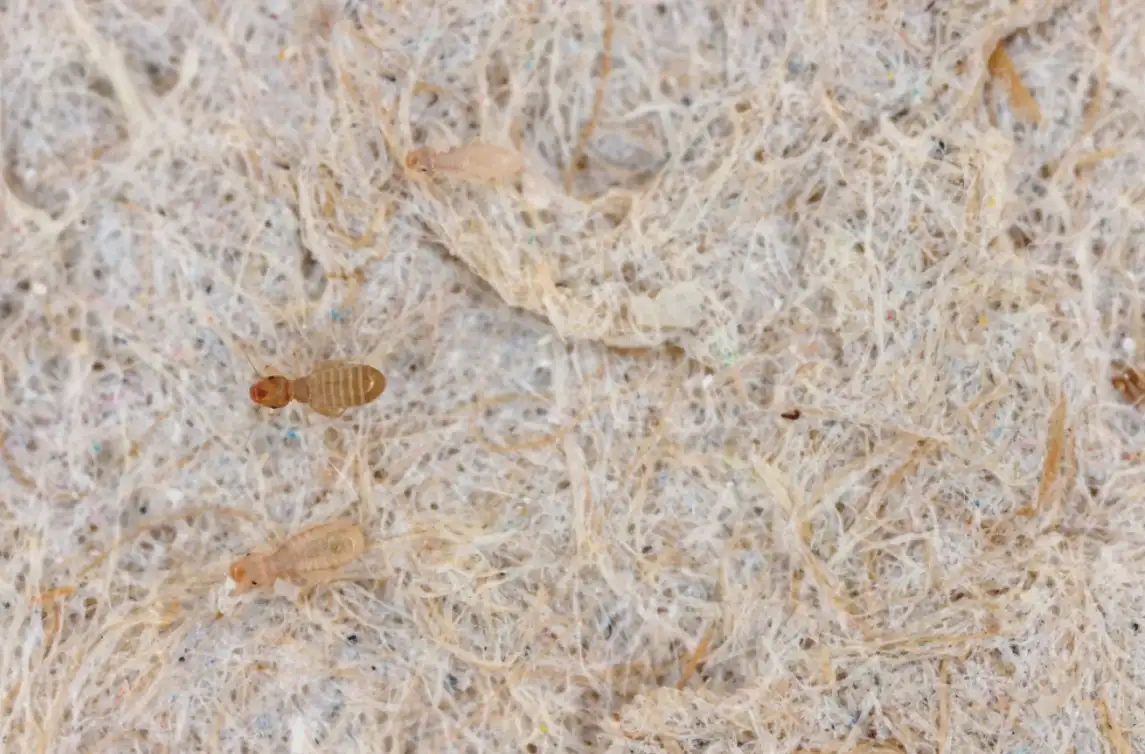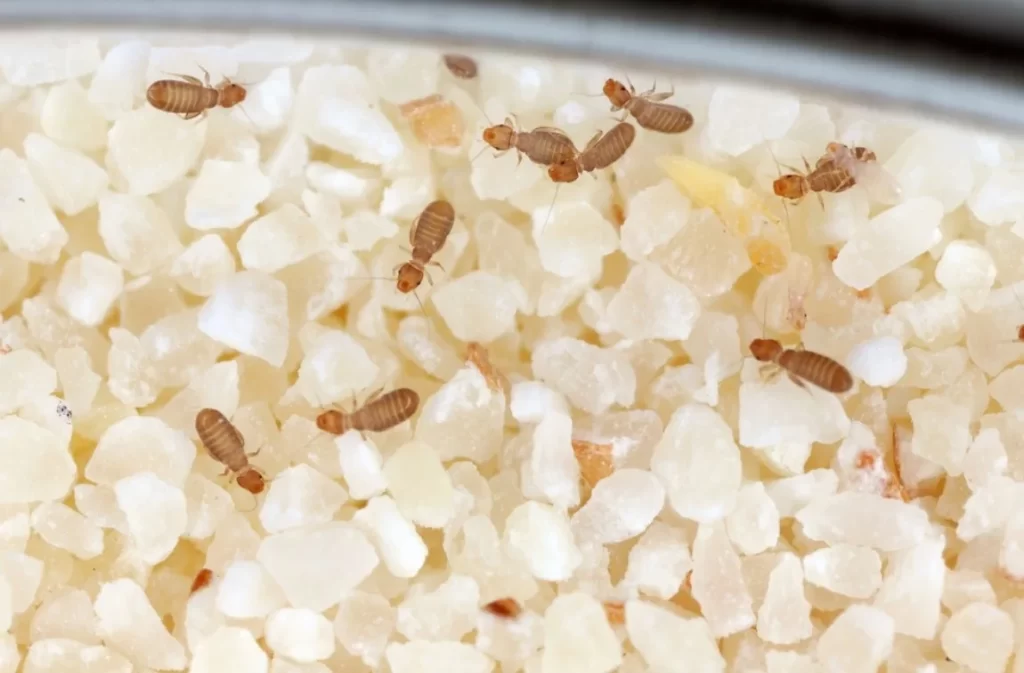In this article, I explore how to get rid of psocids booklice in bed, bedroom and bathroom.
First, I will assess where the booklice come from. This will put you in the know insofar as the cause of the infestation is concerned. Secondly, I will then discuss if they are harmful to humans.
Then I will dive deep into discussing the different effective ways to get rid of the booklice using bleach, essential oils, etc.
Page Contents
Where do Booklice come from?
Booklice are tiny indoor insects commonly found in moist and warm places as well as undisturbed sections of buildings where they feed on molds and fungi.
Their outdoor sister species called “barklice” are commonly found in leaves and under tree bark.
So far, 41 families and 5,500 species of Psocids (pronounced sosids) have been described. Even though generally harmless, Psocids can be nuisances if they grow in numbers.
Read also: Surprising facts about booklice
Booklice in Bed
What can cause booklice to hide in bed? Well, booklice are just like other crawling insects and they can reach wherever they want, including onto your bed.
So as we already stated, they can be creepy and if you have been bitten by bedbugs in the past you can easily get scared after seeing psocids on your bed.
The good news is that should not be worried anymore if you thought they could cause you harm or something. However, you should be concerned about your beddings because they are known to eat the garments.
How to spot a booklice infestation in your bed?
Unless you know what you’re looking for, you probably won’t be able to notice a booklice infestation.
The presence of tiny, white nymphs or adult booklice is a common symptom of a booklice infestation in a bed.
Booklice feces can look like little black specks on your linens and pillowcases. The presence of any of these symptoms warrants immediate action for eradication purposes.
Are Booklice in bed Harmful? Do they bite?
No, booklice do not bite humans and do not cause or transmit diseases. However, booklice might cause allergic reactions, especially in asthma patients.
In their large infestations, booklice can be a menace; they cause destruction to books in shelves, museums and libraries, and furnishings, and they can also mild irritation to the skin.
Pictures of booklice
How to get rid of Booklice in Bed?
Getting rid of booklice in bed is necessary particularly when they become a nuisance in their large numbers.
They are actually not harmful like true lice and do not feed on papers either, but they rather eat mold in old papers and glue that is used in binding books.
These bugs can be found in moist and humid areas in your home including your bedroom. Although they don’t pose any risk to humans, pets, and plants.
The eradication of booklice from your bedroom can be very difficult. However, eliminating moist conditions is crucial for the removal of booklice from your home.
Below are steps you can follow to get rid of booklice from your bedroom.
Step #1 – Understand booklice is vital to remove them from your bed
Understanding booklice is the first step in booklice removal from bed because it will help you to identify and know if indeed your home is infested with these creatures.
The United States has more than 100 species of booklice which are pretty harmless to humans and plants.
These bugs are tiny- about a sixteenth an inch in length and therefore hard to spot. They are prevalent in damp and warm places with fungi and bacteria.
They can also be found in food items and that is why they can be found in the kitchen. Also, note that booklice have no wings hence cannot fly nor even jump.
Steps #2: Remove moisture to prevent booklice from being in your bed
The fact that booklice love humid and damp conditions, these bugs live well in moist unventilated areas in your bedroom and especially your bed where molds and fungi can grow.
On reaching these places, booklice can rapidly increase in numbers as they also reproduce so rapidly.
The solution is to ventilate your bedroom and remove all dampness in the room if you discover they have infested your bedroom.
Dispose of any items in your bedroom that could be conducive for their growth and reproduction in order to avoid possible re-colonization of booklice in your bedroom.
Besides, you should also check for books and bottle labels with glue on which they feed on.
Step #3: Clean your bedroom and your bed
Clean your bedroom and bed thoroughly using a vacuum with a nozzle to reach into crevices.
All the surfaces in the bedroom and bed should be cleaned with warm water using a clean rag. Cleanse all the areas and let them dry.
Keep doors of bedroom cabinets open to make them dry and put off all humidifiers in the room. It is also vital to install all ventilations in the room such as an extractor fan.
Also, let your bed breathe after you wake up in the morning. This is important to have no booklice in bed.
Step #4: Use insecticides to kill booklice in bed
If this method fails to work, you can revert to insecticides to get rid of booklice in bed and in your home in general.
There are many insecticide sprays on the market, but always remember to follow instructions and directions on the label to ensure it works well in removing the bugs from your bedroom.
Step #5: Prevent future attacks of booklice on your bed
It is important to avoid future booklice attacks in your bed, bedroom, and home as a whole. Discovering booklice’s breeding ground and keeping them clean could help you to permanently eradicate booklice from your bed and other areas in your home.
Possible breeding grounds include bed mattresses, furniture, cabinets, and book collections within your bedroom.
Getting rid of these items is crucial and for those items, you cannot do without, always keep them clean and dry.
Read also: The Hidden Dangers of Booklice How These Pests Can Harm Your Health
Booklice vs Bed bugs
Most people often confuse booklice for bed bugs because they look similar. Furthermore, booklice are new to most people.
However, unlike bedbugs, booklice are harmless insects and do not feed on or bite humans or animals. Instead, they feed on dead matter and in particular molds and fungi.
These bugs are tiny in size and light-colored, but unlike booklice that thrive in moist and warm places such as the kitchen and bathroom, bedbugs are prevalent in bed frames.
Bed bugs nymphs have a less elongated body compared to the body of the booklice which also has three segments.
The head is also pronounced and unlike bed bug which appears not to have a neck, booklice nymphs have a clear cut neck.
Booklice in Rice or Flour
As noted earlier, booklice do not pose any significant risk to animals and plants. However, they can spoil foods and boreholes in foods as they seek to hide in there thus causing contamination.
Rice, flour, and grains, in general, provide a conducive environment for mold and fungi especially if they are moist which makes them potential breeding grounds for the booklice.
These bugs have become a considerable pest infesting grain stores including silos.
However, unlike most other pests that invade grain stores, booklice are difficult to spot because they are very tiny- usually the size of dust specks.
In their large numbers, these insects look like a cloud of moving dust on grains, sheds, and silos.
Read also: Do Booklice Bite? Separating Fact from Fiction about These Tiny Pests
FAQs on Booklice Removal
Booklice Bleach
Can I use bleach to remove the booklice?
Booklice bleaches are used to control these tiny crawling insects. They are tiny creatures that crawl on the walls especially in damp places such as bathrooms and bookstores.
Booklice are found indoors and can be wiped down from homes using oxygen, chlorine, and ammonium bleaches.
Other bleaches with dehydrating properties such as hydrogen peroxide can also be used to get rid of booklice from your home and living areas.
Booklice Essential Oil Eradication
Can I use essential oils for booklice extermination or eradication?
Yes, you can use essential oils to get rid of booklice from your home and garden. These oils are amazing because they are natural and would do no harm to yourself and the environment.
Some of the essential oils you can use include:
These oils are also highly absorbent because they are coarse and porous. Furthermore, these essential oils can be used by simply sprinkling or spraying them around your home.
Psocid Treatment
Treating psocid infestation is necessary because they can become annoying especially in their huge numbers. These creatures are simple to eradicate using the right products and they are easy to eliminate from your home.
However, some maintenance is necessary for noted areas to prevent their re-occurrence.
Common products used for psocids treatment are PT-565XLO. This product is easy to use with no mess and can also penetrate the cracks and crevices where they love to hide.
You can also use natural and artificial chemicals. One particular example is Diatomaceous Earth (DE) which originates from the word “diatom” for the organism.
This is a chalk-like substance, usually in powder form made from diatoms fossilized over thousands of years.
Although harmful to insects because of its dehydrating properties, DE contains no toxic substance and is safe for humans and animals.
You can be sure of no mess, just mist the infested areas and it will definitely yield quick positive results.
How to Get Rid of Booklice in bed | Just 14 Steps to Solved Booklice Problem
READ: What kills booklice?
- Where Can I Purchase Bed Bug Bombs? - January 30, 2023
- Where Can I Buy Something to Kill Bed Bugs? - January 30, 2023
- Where Can I Buy Bed Bug Spray? - January 30, 2023


